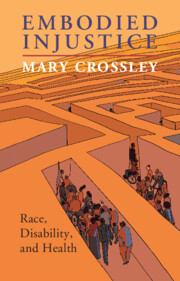Book contents
- Embodied Injustice
- Embodied Injustice
- Copyright page
- Dedication
- Contents
- Acknowledgments
- 1 Introduction
- 2 Health Disparities Based on Race and Disability
- 3 Biology’s (In)significance
- 4 Medical Mistrust
- 5 Maligned Mothers
- 6 Medicaid Preservation
- 7 Beyond Health Care
- 8 COVID Stories
- 9 The Busy, Troubled Intersection of Blackness and Disability
- 10 Conclusion
- Index
6 - Medicaid Preservation
A Shared Priority
Published online by Cambridge University Press: 18 August 2022
- Embodied Injustice
- Embodied Injustice
- Copyright page
- Dedication
- Contents
- Acknowledgments
- 1 Introduction
- 2 Health Disparities Based on Race and Disability
- 3 Biology’s (In)significance
- 4 Medical Mistrust
- 5 Maligned Mothers
- 6 Medicaid Preservation
- 7 Beyond Health Care
- 8 COVID Stories
- 9 The Busy, Troubled Intersection of Blackness and Disability
- 10 Conclusion
- Index
Summary
On July 28, 2017, Senator John McCain walked onto the floor of the Senate Chamber and into the middle of an intense congressional debate over the future of health care in the United States. Since earlier that year, a Republican majority in Congress had been pushing proposals to repeal the Affordable Care Act (ACA) and make fundamental changes to the Medicaid program. Although McCain previously had expressed his opposition to the ACA, at the time of the vote, his support for the repeal legislation was in question. McCain entered the chamber as voting was underway. Instead of heading to his seat on the Republican side of the chamber, he paused before the Senate chair and extended his arm. Then came McCain’s dramatic gesture: Thumb’s down on the bill. With that simple motion, McCain upended Republican efforts to scuttle a central piece of President Obama’s legacy. He also preserved the existing structure of Medicaid against Republican efforts to weaken and shrink it, efforts that posed especial threats to Black Americans and disabled Americans.1
Keywords
- Type
- Chapter
- Information
- Embodied InjusticeRace, Disability, and Health, pp. 128 - 151Publisher: Cambridge University PressPrint publication year: 2022

